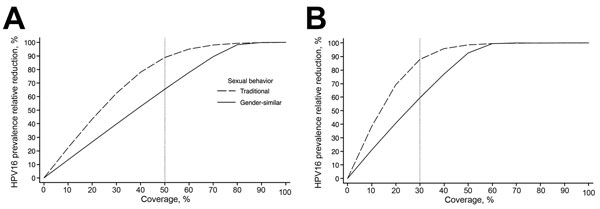Volume 22, Number 1—January 2016
Research
Human Papillomavirus Vaccination at a Time of Changing Sexual Behavior
Figure 1

Figure 1. Relative reduction of prevalence of human papillomavirus type 16 at postvaccination equilibrium (i.e., 70 years after the introduction of vaccination) attributable to vaccination among women 20–34 years of age after vaccination of 11-year-old girls or 11-year-old girls and boys, by coverage and a population’s age-related sexual behavior. A) 30% vaccine coverage; B) 50% vaccine coverage. Traditional sexual behavior indicates a population in which genders have different age-specific sexual activity rates and a wide gap in ages (e.g., an average of 5.6 years, as observed in India) of spouses or cohabitating sexual partners. Gender-similar sexual behavior indicates a population in which genders have similar age-specific sexual activity rates and a narrow gap in ages (e.g., an average of 2.1 years, as observed in the United States) of spouses or cohabitating sexual partners.